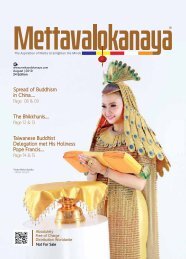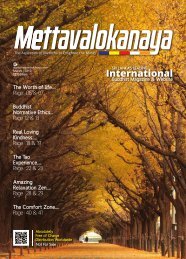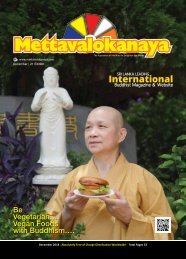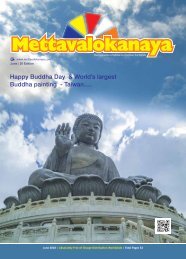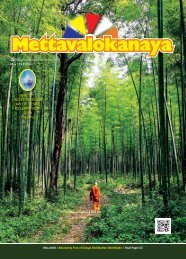mettavalokanaya_international_buddhist_magazine_september_2020
This is the Sri Lankan's Most Popular & Leading Monthly International Buddhist Magazine, “Mettavalokanaya” on September - 2020 Edition - 29. “Mettavalokanaya” International Buddhist Magazine has been successfully distributed to 40 countries worldwide. Specially distributed to Overseas High Buddhist Monks, Masters, Nuns, Worldwide famous Buddhist Monasteries & Associations, International Buddhist conferences and Forums. “Mettavalokanaya” International Monthly Buddhist Magazine has been awarded as the “2018 - The Global Buddhist Ambassador Award” from Thailand as the World’s Best and Most popular Buddhist Magazine. The Mettavalokana Buddhist Publications Centre is a registered Buddhist Publications Centre in Sri Lanka and has received many International accolades. Our publications are absolutely free of charge to general public. The magazine comprises of special articles on Buddhism written by leading Buddhist Monks from foreign countries. “Mettavalokanaya” is currently been published in English and includes full color 60 pages.
This is the Sri Lankan's Most Popular & Leading Monthly International Buddhist Magazine, “Mettavalokanaya” on September - 2020 Edition - 29. “Mettavalokanaya” International Buddhist Magazine has been successfully distributed to 40 countries worldwide. Specially distributed to Overseas High Buddhist Monks, Masters, Nuns, Worldwide famous Buddhist Monasteries & Associations, International Buddhist conferences and Forums. “Mettavalokanaya” International Monthly Buddhist Magazine has been awarded as the “2018 - The Global Buddhist Ambassador Award” from Thailand as the World’s Best and Most popular Buddhist Magazine. The Mettavalokana Buddhist Publications Centre is a registered Buddhist Publications Centre in Sri Lanka and has received many International accolades. Our publications are absolutely free of charge to general public. The magazine comprises of special articles on Buddhism written by leading Buddhist Monks from foreign countries. “Mettavalokanaya” is currently been published in English and includes full color 60 pages.
Create successful ePaper yourself
Turn your PDF publications into a flip-book with our unique Google optimized e-Paper software.
“Harmony
with our
Lives”….
Body & Mind
Together….
I
have a mantra that I teach my
students: Wherever the body is, the
mind is there; whatever the body is
doing, the mind is doing it too. Body
and mind should be together. When we
walk, we just walk. When we sit, we
just sit. The body shouldn’t be doing
something while the mind is wandering
off. Body and mind together. This is not
to say that we can’t experience deep,
meaningful states of absorption when
we’re during thought or working out a
problem. And there are also meditative
states where the external environment
drops away and the mind is unified and
fully engaged.
Most of the time, however, we’re
simply living our lives, going about our
day-to-day tasks. The mantra helps us
to be aware, to keep coming back into
the present moment, to not get lost in
our emotional states and daydreams
and lose ourselves in the stories we
generate to explain and justify why we
feel this way or that. The environment
in which we live reflects our mental
state. Everything is, in fact, a projection
of the mind. If the mind is scattered,
then our home will have things strewn
about: bits and pieces everywhere. We
will misplace and lose things.
Since I learned meditation twenty
years ago, I don’t remember misplacing
or losing anything. When I’m traveling,
I can call my monastery in Singapore if
I need something sent to me and tell
the person on the phone exactly where
it is. I’m not bragging about this ability;
it’s something very simple, very natural.
Practice returning things to their places.
If your room is messy, tidy it up. Don’t
go about your life in a daze. Body and
mind together. If we diligently practice
this mantra, we will naturally come
back into harmony with our lives. The
practice leads us back to the present,
to the here and now, to what is real
rather than projection and illusion.
When body and mind are unified, we
are in the moment. Our attention is on
what is happening now, and we’re fully
engaged. Fully alive!
We will naturally enter a very
relaxed state if we practice body
and mind together. Relaxation is not
inertia, however; it’s not lax, casual, or
careless. Relaxation means not being
affected, distracted, or disturbed.
It’s a state of serene clarity. It’s both
receptive and responsive. The Buddha
was the most relaxed person in the
world. That doesn’t mean he was
the most comfortable person. You
can be extremely uncomfortable and
still be perfectly relaxed. Relaxation
is a state of openness. Nongrasping.
Clarity without exertion, force, or
pressure. The flexibility to adapt to each
moment. Buddhahood is the perfection
of relaxation. To attain this kind of
relaxation, practice the mantra of body
and mind together. Wherever the body
is, the mind is there. Whatever the body
is doing, the mind is doing it too. Very
simple. Very easy. Direct and ordinary.
Body and mind in unison. Harmony.
Body and mind always together.
Chan does not use logic and
intellect, although we have nothing
against them. Chan is experiential. We
stay in the present moment, and we
keep returning to it. We are always in
process, always in flux, always changing,
with no fixed point. In whatever we
do, we relax and open our awareness.
If we’re relaxed and open, there’s a
feeling of gentleness. Tenderness. We’re
naturally moved by a desire to help. We
feel connected and compassionate.
The word for “compassion” in Chan
is cibei. In Chinese, ci means “giving
happiness.” The top part of the
character is traditionally translated as
“silk,” implying softness. The bottom
part of the character translates as
“heart” or “mind.” We use cibei in Chan
today to mean “to give happiness and
remove suffering.” We hope others will
be happy, and if possible, we will give
them happiness. It means to remove
and give. Give and remove. We cultivate
this response to life by always coming
back to the present moment. As I’ve
said: wherever the body is, the mind is
there; whatever the body is doing, the
mind is doing it too. It takes discipline to
live like this, yet it is also very relaxed,
very easy.
In Chan, we shy from analysis
and arguments. Chan is engaged with
the intuitive, rather than with what
can appear—at least on the surface—
as the rational. Take, for example, the
meditation retreats I lead. Is it rational
to go up into the mountains and
sequester oneself for a week or two,
waking at 4:00 a.m. and sitting, silent
and unmoving, for hours? When we
analyze something, pick it apart, we do
it from our own perspective. The fixed
point of the self generates our everyday
outlook in life. Everything refers to I,
me, me. The whole world is about me. A
self-referential worldview can produce
knowledge, but only knowledge of
the self. You see yourself as subject
and everything else as object. You
think you can manipulate everything,
and this leads to hubris. Our inflated
sense of our own importance leads
to bloodshed, oppression, and the
degradation of nature. It indicates a
lack of care, gentleness, kindness, and
respect.
Its attitude is “I am what’s most
important. The universe is here to serve
me!” What misery this creates! And yet
if we stop and intuitively attune to the
majestic complexity of creation, we can
only feel humility and gratitude. Nature
keeps giving and giving. Endlessly
giving. Every moment is a miracle. To
know this intellectually is one thing. To
feel it, to live it, is another. We live our
lives unable to see beyond the self, hear
beyond the self, have an understanding
that is beyond the self. A reality beyond
the self is beyond our experience. Chan
calls “knowledge” zhishi. “Wisdom”
is zhihui, which we write by putting
the character for the sun below the
Singapore
Most Venerable
Master Zhengyan
Guo Jun Thero
character for knowledge. The sun shines
on everything; wisdom is pervasive.
Nonjudgmental. Knowledge, on the
other hand, is a narrow beam of light.
Its focus and direction are limited.
In Chan, we have an expression:
Ge teng luo suo. It means our mode of
analysis is like a creeping vine, the type
of plant that grows up and around a
fence. It just goes round and round and
in and out of the fence and becomes
increasingly entangled. Our reasoning
may be subtle and complex, but we’re
still inexorably attached to the fence.
In other words, we are unable to break
away from the framework of the self.
A mind consumed by analysis can
go crazy. It’s like an engine that runs
faster and faster. In the end, the engine
catches fire and explodes. Keep coming
back to the present moment. Over and
over. Body and mind together—walking,
talking, eating, drinking. This is how we
expand our awareness and manifest
compassion even when it seems to defy
logic and goes beyond what we can
intellectually understand.
8 l Mettavalokanaya l September l 2020 2020 l September l Mettavalokanaya l 9











